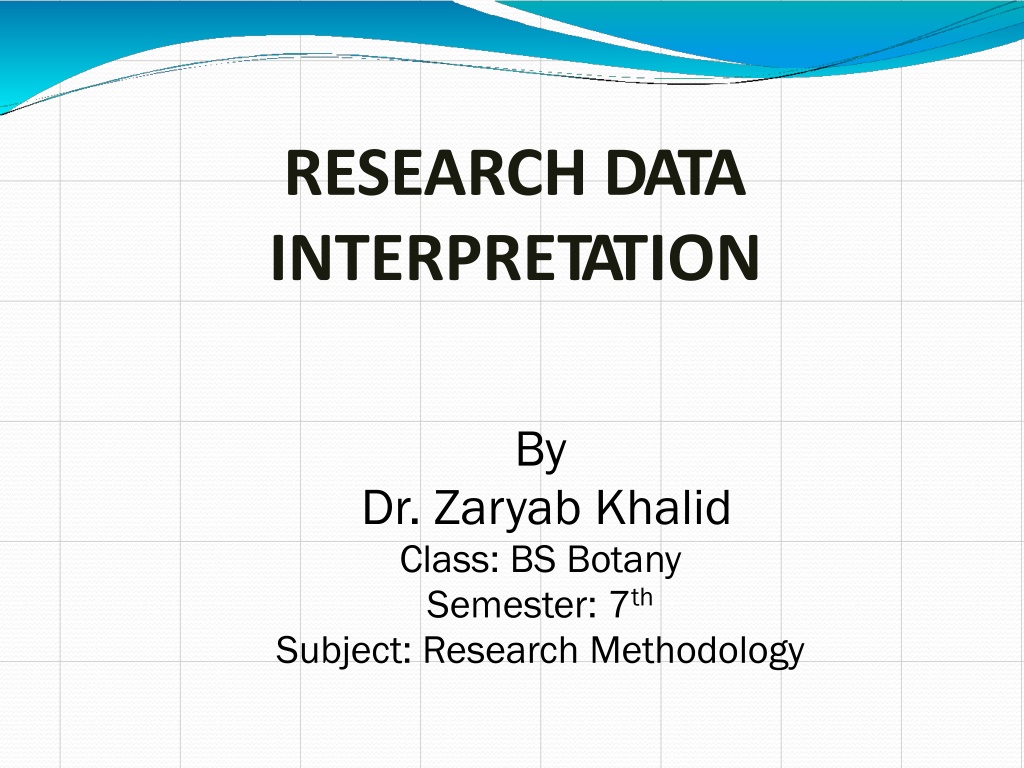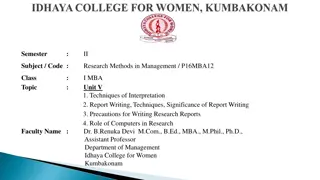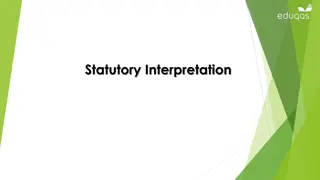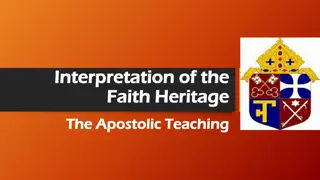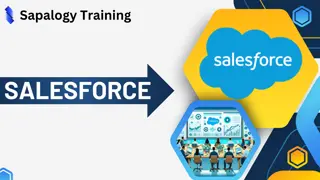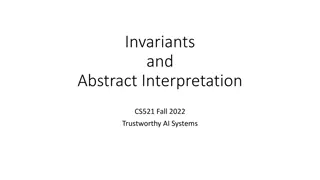Research Data Interpretation
Principles and methods of data interpretation in research, transitioning from data to knowledge through analysis and inference. Importance of proper interpretation for drawing accurate conclusions and enhancing the value of research findings.
Download Presentation

Please find below an Image/Link to download the presentation.
The content on the website is provided AS IS for your information and personal use only. It may not be sold, licensed, or shared on other websites without obtaining consent from the author.If you encounter any issues during the download, it is possible that the publisher has removed the file from their server.
You are allowed to download the files provided on this website for personal or commercial use, subject to the condition that they are used lawfully. All files are the property of their respective owners.
The content on the website is provided AS IS for your information and personal use only. It may not be sold, licensed, or shared on other websites without obtaining consent from the author.
E N D
Presentation Transcript
RESEARCH DATA INTERPRETATION By Dr. Zaryab Khalid Class: BS Botany Semester: 7th Subject: Research Methodology
All meanings, we know, dependon the key of interpretation. -GeorgeEliot 2
Principles of Analysis and Interpretation Data, as used in behavioral research, means research results from which inferences aredrawn: usually numerical results, like scores of tests and statistics such as means, percentages, and correlationcoefficients. Analysis means the categorizing, ordering, manipulating, and summarizing of data toobtain answers to researchquestions. Interpretation takes the results of analysis,makes inferences pertinent to the research relations studied, and draws conclusions about these relations.
Methods of data interpretation Direct visual observations of rawdata Afterorganizingthedataintables After making Graphicalrepresentations After calculations using numerical/ statistical methods After mathematicalmodelling
DATA Data is known to becrude information and not knowledge byitself. The sequence from datato knowledge is: from Data toInformation, from Information to Facts, andfinally, from Facts toKnowledge.
DATA Data becomes information, when itbecomes relevant to your decisionproblem. Informationbecomesfact,whenthedatacan supportit. Factsarewhatthedatareveals. However the decisive instrumental (i.e.,applied) knowledge is expressed togetherwith some statistical degree ofconfidence.
Fact becomes knowledge, when itis used in the successful completion of a decisionprocess. massive amount of factsare integrated asknowledge.
Usefulnessand utilityof research findings lie inproper interpretation. Interpretationisabasiccomponentof research. Aftercollectingandanalyzing thedata, theresearcher has to accomplish the task of drawing inferences followed by reportwriting. This has to be done very carefully, otherwise mis conclusionsmaybedrawnand thewholepurposeof doing research may getvitiated. It is only through interpretation that the researcher can expose relations and processes that underlie his findings.
Meaning of Interpretation Interpretationreferstothetaskof drawing inferences from the collected facts after an analytical and or experimentalstudy. In fact, itisasearch forbroadermeaningof research findings. Thetaskof interpretation hastwomajoraspectsviz., theefforttoestablishcontinuityinresearch through linking the results of a given study with those of another,and theestablishmentof someexplanation concepts.
In one sense, interpretation is concerned with relationships within the collected data,partially overlappinganalysis. Interpretation also extends beyond the data of the study to inch the results of other research, theory andhypotheses.
Interpenetration is the device Thus, interpenetration is the device through which the factors that seem to explain what has been observed by researcher in the courseof thestudycan bebetterunderstood and it also provides a theoretical conception which can serve as a guide for further researches.
Why Interpretation? Interpretation is essential for thesimple reason that the usefulness and utility of research findings lie in proper interpretation. Itis beingconsideredabasiccomponentof research process because of the following reasons:
Through interpretation It is through interpretation that the researcher can well understand the abstract principle that works beneath hisfindings. Through this he can link up his findings with those of other studies, having the same abstract principle, and thereby can predict about the concrete world of events. Fresh inquiries cantest these predictions lateron. Thiswaythecontinuityinresearchcanbe maintained.
Interpretation of the findings The interpretation of the findings of exploratory research study often results into hypotheses for experimental research and assuch interpretation is involved in the transition from exploratory to experimentalresearch. Since an exploratory study does not have a hypothesistostartwith, thefindingsof sucha study have to be interpreted on a post factum basisinwhichcasetheinterpretationis technically described as postfactum interpretation.
Technique of Interpretation The task of interpretation is not an easy job, ratheritrequiresagreatskillanddexterityonthe part of researcher. Interpretationisanartthatonelearnsthrough practice andexperience. Theresearchermay,attimes,seektheguidance from experts for accomplishing the task of interpretation.
The technique of interpretation The technique of interpretationoften involves the followingsteps: 1. Researcher must give reasonable explanations of the relations which he/she has found and he/she must interpret the lines of relationship in terms of the underlying processes and must trytofindoutthe threadof uniformitythatlies under the surface layer of his diversified researchfindings. In fact, this is the techniqueof how generalization should be done and concepts beformulated.
2. Extraneous information, if collected during the study, must be considered while interpreting the final results of research study, for it may prove to be a key factor in understanding theproblem underconsideration.
3.It is advisable, before embarking upon final interpretation, to,consultsomeonehaving insightintothestudyand who is frank and honest and will not hesitate to point out omissions and errors in logical argumentation. Such a consultation will result in correct interpretation and, thus, will enhance the utility of researchresults. 4. Researcher must accomplish the task of interpretationonly after considering all relevant factors affecting the problem to avoid false generalization. He /she must be in no hurry while interpreting results, for quite often the conclusions, whichappeartobeall rightatthebeginning, maynotatall beaccurate.
Precautions in Interpretation One should always remember that even if thedataareproperlycollectedandanalyzed, wrong interpretation would lead to inaccurateconclusions. It is, therefore, absolutely essential thatthe task of , interpretation be accomplished with patience in an impartial manner and also in correctperspective.
For correct interpretation Researchermustpayattentiontothefollowing points for correctinterpretation: (i)Attheoutset,researchermustinvariablysatisfy himself that (a) thedataareappropriate, trustworthyand adequate for drawinginferences; (b) the data reflectgood homogeneity; and that (c)properanalysis has beendonethroughstatistical methods. (ii) Theresearchermustremaincautiousaboutthe errors that can possibly arise in the process of interpreting results.
Errors can arise due to false generalization Errors can arise due to false generalization and/or due to wrong interpretation of statistical measures, suchas the application of findings beyond the range of observations, identification of correlation with causation . and thelike. Anothermajorpitfall isthetendencytoaffirm that definite relationships exist on the basis of confirmation of particularhypotheses.
Researcher must remain vigilant Infact, thepositivetestresultsacceptingthe hypothesis must be interpreted as being in accord with the hypothesis, rather than as confirming the validity of thehypothesis . The researcher must remain vigilant about all suchthingssothatfalsegeneralization maynot takeplace. He/she should be well equipped with and must know the correct use of statistical measures for drawing inferencesconcerning hisstudy.
Researcher must always keep in view that the task of interpretation is very much intertwined withanalysisandcannotbedistinctlyseparated. Assuch hemusttakethetaskof interpretationas a special aspect of analysis and accordingly must take all those precautions that one usually observes while going through the process of analysis viz., precautions concerning the reliability of data, computational checks, validation and comparison ofresults.
Data Interpretation Methods Datainterpretation maybethemostimportantkeyin proving or disproving yourhypothesis. Itisimportanttoselecttheproperstatisticaltool to make useful interpretation of yourdata. If youpickan improperdataanalysismethod,your resultsmaybesuspectand lackcredibility.
Visually scanning the data Before doing any statistical analyses of thedatayouhavecollected, lookclosely at the data to determine the best method of organizing it. By visually scanning the data and reorganizing it, you may be able to spot trendsorotheranomaliesthatmayhelp youinyouranalysisof thedata.
STATISTICS Statisticsisascienceassistingyouto make decisionsunder uncertainties (based on somenumerical and measurablescales). Decision making process must be based on dataneitheronpersonalopinion noronany belief.
What is Statistical Data Analysis? Data are not information! To determine what statistical data analysis is, one must firstdefine statistics. Statistics is a set of methods that are used to collect, analyze,present, and interpretdata.
Statistical methods Statistical methods are used in a wide variety of occupations and help people identify, study, and solve manycomplex problems. In the business and economic world, these methods enable decisionmakers and managers to make informed and better decisions about uncertain situations.
Usingstatisticstodeterminerelationshipsis paramount to thesuccess of good research. Using tools such as ANOVA, correlations, Fisher ExactTests,regression,etc.canpredictwhetheror notyour research hypothesis is satisfied. But, REMEMBERtoselectyourp-valuebeforeyou begin your researchproject. Doing thiswilladdcredibilitytoyourresearch.
One other important point to remember when doingdataanalysisistouseparametricstatistics instead of nonparametric statistics whenever possible. Rememberthatparametricstatisticsreliesonthe assumptions of normality, which gives greater power than nonparametrictesting. Both parametric and nonparametricstatistical tests are used forinterpretation.
Statistics consists of Statisticsconsistsof theprinciplesand methodsfor Designingstudies Collectingdata Presenting and analysingdata Interpreting theresults Statistics has been describedas Turning data intoinformation Data-based decisionmaking.
Scientistsinterpret data based on their background Scientists interpret data based on their background knowledge and experience; thus, differentscientistscan interpretthesamedata in differentways. By publishing their data and the techniques they used to analyze and interpret those data,scientists give the community the opportunity to both reviewthedataand usethem infutureresearch.
